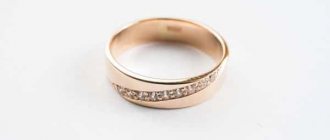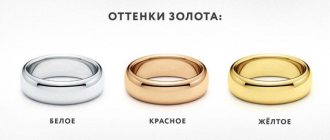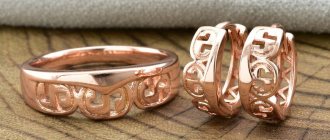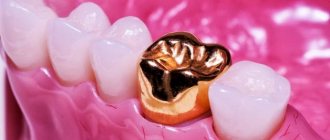Today, many people prefer to wear gold jewelry. One of the most popular and expensive metals used for making jewelry is white gold alloy. When buying jewelry, many cannot understand what is the difference between white and yellow metals? After all, the sample of white gold is no different from the sample of yellow gold.
A few words about metal
Gold jewelry has always been considered an indicator of wealth. Wealthy citizens often choose jewelry made from the colorless variety of this precious metal. Today, the composition of gold has undergone changes. Gold without impurities is not used, as it is too soft a metal.
In order for its properties to become hard, a part of another metal is added to the composition of gold. Impurities such as silver and nickel are added to colorless metal alloys, and for yellow gold, an admixture of copper and silver is used. Some options may use palladium and platinum, but the addition of these metals significantly increases the price of jewelry.
When purchasing gold jewelry, it is worth considering the fact that the hallmark number of white gold cannot be higher than 750. In order for this metal to acquire a white tint, it is necessary to add at least 18% of an admixture of the same white metal. After adding a ligature to a common precious alloy, it acquires the necessary hardness for creating jewelry masterpieces. The white variety has a unique shine similar to that of diamonds or platinum.
Samples of noble alloys
There are several systems for determining fineness in the world, but the most popular are metric, carat and spool. The international standard of carat fineness in conversion corresponds to the following percentage of the noble element:
- 24 Karat – 100% alloy;
- 18 Karat – 75%;
- 14 Karat – 58.5%;
- 12 Carat – 50%;
- 9 Carat – 37.5%;
- 8 Carat – 33.3%.
The high-grade group includes metal containing 24 and 18 carats (999 and 750 samples), the medium - 14 and 12 (585 and 500 samples), and the low-grade group - 9 and 8 carats (375 and 333). The cost of white gold is quite high and depends on the number of carats, that is, the content of the noble element in the jewelry alloy. The approximate price of white gold is determined based on the sample number of the product.
How did this alloy come about?
In the first half of the 20th century, many European jewelry lovers fell in love with this metal for its color, which looked ideal in combination with pearls and diamonds.
At that time, silver alloys were often used, but silver was not of very good quality, so high society chose jewelry products made from white precious metal with the addition of nickel. But it turned out that the latter causes allergic reactions and is not suitable for jewelry making. In our country, an admixture of copper was added to the composition, which gave the jewelry a reddish tint and did not look decent. This type of precious metal in Russia is still produced today with low-quality silver alloys. Such products, which have a purity of 375 and 500, should be treated with caution .
Properties
In principle, the properties can be different. First of all, this is determined by the sample, as well as the ligature. Gold can be used in three states. For jewelry work, they take the hard, the base is made from the soft, and other metals are coated with the liquid. White gold is in demand because, unlike yellow, diamonds will not turn yellow. That is why it is used in the West for engagement rings.
This alloy is sometimes used in combination with others, such as yellow. Thus, jewelers experiment, giving the product a special beauty. Rare shades that are now popular, such as blue, cyan and purple, are combined in products with a white alloy. It contrasts best with them, giving depth and richness of color.
It is not surprising that it is the white gold alloy that is used in all styles of jewelry, from classics to bold solutions. Depending on its composition, it can be available to everyone, from students to the richest people.
Strengths and advantages
With the admixture of high-quality metals, a more noble composition is obtained, suitable for making jewelry. This metal is easy to process and retains its shape for a long time. Not only the beauty of the white appearance of the precious metal helps to make a product unique, but also the fact that many types of precious stones can be set in it very easily. It is in combination with colorless gold that products with stones are most often found. The noble metal harmoniously sets off the jewelry stone with its light. Several types of metal give gold an attractive white hue:
- silver;
- platinum;
- palladium;
- zinc;
- nickel.
Jeweler's comment
Molokanov N.M.
Jeweler, 26 years of experience in jewelry production.
In addition to the main signs of the quality of jewelry (the sound of falling on glass, color, weight), you can focus on price. This is an indirect factor and cannot be taken as the main one. However, most often low-quality products or counterfeits are sold at reduced prices.
Main differences between precious metals
The white appearance of the precious metal in comparison with platinum can be distinguished by paying attention not only to the color, but also to the chemical composition. Colorless gold contains additives of other metals, but platinum does not contain them. So, the manufacturer can make inclusions of nickel, and this, in turn, quite often provokes allergic reactions. If platinum is added to the main material, then you don’t have to worry about allergies - it doesn’t cause them.
There are practically no small parts in platinum products, since this natural material is very durable and difficult to process. Jewelry made from pure platinum is very expensive and often has its own hallmark. It will be difficult for a non-professional person to distinguish platinum from colorless gold. When purchasing, you should always ask for documents for the product, and also look at the hallmark.
Application of white gold: 375, 500, 585, 750 samples
There are several options for white precious metal, among them there are those that represent the low, medium and high price categories. You can determine the quality by the composition - sample. Happens:
- 375: the most affordable alloy, contains a minimum of precious metal (37.5%), the rest of the share falls on budget additives (usually silver is used), the metal is sometimes used in the production of jewelry and only some of their types, more often it is used for the manufacture of fastenings for inserts of various products, production of cigarette cases, watches;
- 500: gold is used infrequently due to its low fusibility, suitable for the production of eyeglass frames, various decorations, watches, often used to verify the authenticity of products, used by assay supervision services;
- 585: universal material, considered the best in its price category, suitable for making various jewelry;
- 750: gold of high standard and excellent quality allows you to create jewelry, but the finished products are inferior in properties to jewelry of 585 standard, because they are not resistant to mechanical damage.
Sample determination methods
A very important criterion for determining the quality of a colorless precious metal is the sample. And it is very important to be able to determine what standard is on white gold.
Fineness is the ratio of the precious metal to the amount of impurities in the composition. There are only two types of sample systems: carat and metric systems. As a rule, in Europe and Russia they use the metric system. Colorless gold is the main metal used in jewelery making and its hallmarks are used in accordance with international standards. In the domestic production of white gold products, strict GOST standards are adhered to. It is important to know what types of white gold there are. 5 types of samples are used:
- 375 sample. This sample contains only 37.5% gold, and the remaining 62.5% is impurities from zinc, silver or nickel. Products with this hallmark are not of very high quality and tend to fade over time.
- 500 sample. Here the ratio of gold is 50% and impurities are 50%. The alloy contains silver and copper. This composition is quite difficult to process, so jewelers try to avoid this composition in their work.
- 585 sample. A frequently used sample. The composition includes 58.5% gold, and the rest is impurities from silver, palladium or copper. This alloy is considered quite durable and hard and is widely used by jewelers in production. Products made from 585 standard are very wear-resistant and do not fade over time.
- 750 sample. Very high quality composition, it includes 75% gold. This alloy is mainly used for the manufacture of elite, expensive, filigree products. Products of this sample are not suitable for daily wear, as they are prone to damage.
- 958 sample. It is very rarely used in production, since the main part 95.8% consists of gold. Such proportions produce a soft alloy, and are used mainly for making parts on jewelry, but not as a base material.
In Russia, only these types of samples are used .
Other countries may use different samples. For example, in Turkey they can supply any sample to order. Unlike domestic producers, where everything is controlled by law, no one monitors this.
Ligatures made of simple metals for white gold
One of the first metals that jewelers began to experiment with was nickel. When combined with gold, it acted as an excellent brightener. In terms of percentage, it was approximately comparable to platinum. To make it more ductile, copper or silver is sometimes added to the alloy. So, 750 sample contains:
- 1 part Ag;
- 4 parts Ni;
- and 15 parts Au.
Despite all the positive characteristics of nickel, its high allergenicity was discovered. For approximately 1/8 of the planet's inhabitants, jewelry using this metal causes various types of dermatitis. That is why, since 2000, this chemical element has not been used in the production of jewelry, costume jewelry and wristwatches in the European Union.
The white metals manganese and zinc in alloys have proven themselves to be secondary brighteners. With their participation, you can create 750-carat white gold, but not higher.
Unfortunately, their high content in products also turned out to be toxic. After 2-3 years of constantly wearing rings or earrings made of such white gold, the owners began to experience severe headaches and other negative manifestations. Thus, these ligatures also had to be abandoned.
How to spot a fake
Due to the high demand for white gold, a very common type of fraud has emerged. Interested buyers are offered to purchase jewelry at a low price with a quality mark of 925. People, without thinking, purchase jewelry, rejoicing that they bought an expensive product at a low price.
However, it later turns out that 925 is a silver standard. To avoid such situations, you need to contact only large jewelry stores with a quality certificate for all products. In an attempt to save money by buying gold secondhand or at a pawnshop, you may encounter scammers and give your money for a low-quality product.
White gold: composition, appearance, cost 4 features of white gold that make you fall in love
White gold is called elite, which is difficult to argue with. A noble and at the same time delicate shade, a pleasant muted shine, a chance to be combined with expensive “decorations” of jewelry frames - black pearls, diamonds and sapphires - this makes white gold, the alloy of which we will discuss below, a dream gift for women and the first gift idea for them. men.
Shades of white gold in a jewelry store include both snowy white with a metallic sheen and honey, which is confused with traditional yellow gold. However, white gold is confused with both its reddish “brother” and silver. Find out what white gold is and whether it's right for you by reading this article!
How not to be confused with silver
This problem will be relevant for those who have not fully gotten used to trusting even the samples that are indicated on the products. From the outside, the metals are literally indistinguishable, but even an amateur can distinguish a fake. Knowledge of such subtleties will help reduce the influx of counterfeit items that are presented as particularly precious items, but in fact they are made of silver, the cost of which is an order of magnitude lower.
Basic testing methods: visual examination of the sample, the shine of the product, as well as chemical data on strength, hardness, survivability in acidic and alkaline environments, monitoring the response to iodine.
White gold, without exaggeration, is the most popular precious metal in our country; it is always affordable and is a fairly wear-resistant material.
Such jewelry can be worn by people of any age, gender and social status. The best gift for any occasion would be a piece of white gold jewelry.
HOW TO DISTINGUISH WHITE GOLD FROM A FAKE BY ITS PHYSICAL PROPERTIES
If you have any doubts about the authenticity of the product, you can check its properties.
First of all, it's weight. The gold product is very heavy, but does not react to magnets. Some metals are also not magnetic, but they are much lighter in weight. The only metal that is “indifferent” to a magnet and has a similar weight to gold is lead. But lead is a very soft metal. That is, a crude fake will either be suspiciously light, or will react to a magnet, or will be easily scratched.
You can distinguish gold from ordinary silver, if you have difficulty identifying metal by shades, by running the jewelry over paper. Unplated silver will leave a gray mark. If the silver is rhodium-plated, it is impossible to distinguish it from gold by its appearance. But silver is much softer and scratches more easily. You can easily bend a protruding part of a silver item or scratch it.
We recommend reading: How to find treasure without a metal detector?
Comparison with yellow gold
Choosing between these materials is a matter of personal preference.
However, keep in mind that white gold jewelry must be re-plated with rhodium after a certain period, which usually ranges from 1 to 3 years.
However, a gemstone setting made from a white gold alloy is more durable as compared to a yellow one of the same carat.
If you are going to set stones in your gold jewelry, you need to consider their color when choosing white and yellow gold settings.
For example, colorless diamonds are best set in a white setting that does not cast additional flashes of color on the colorless stone.
However, if your diamond is a lower color grade, the stone may have yellowish tints that will become even more noticeable when set in a white setting.
In such cases, it is better to choose a yellow setting as it will make the yellow tones less visible, making the white color in the diamond stand out.











